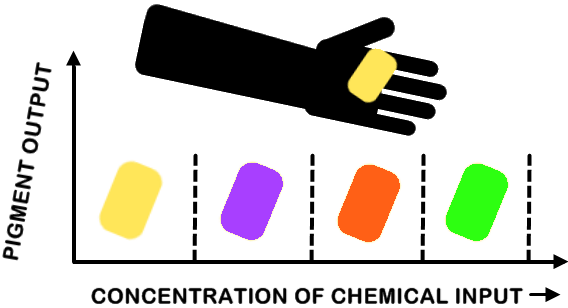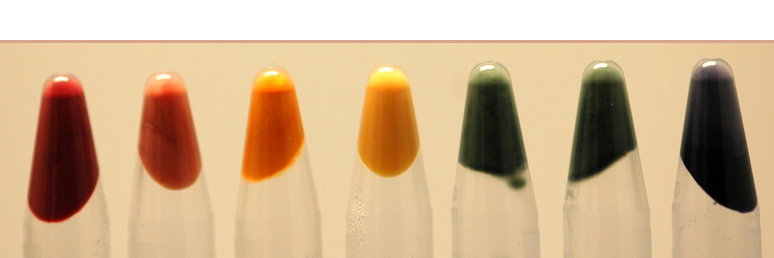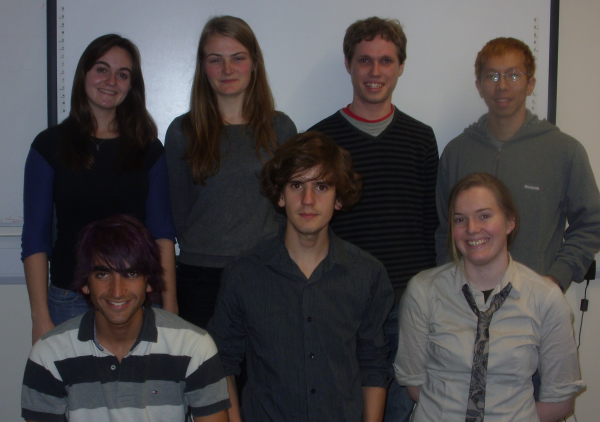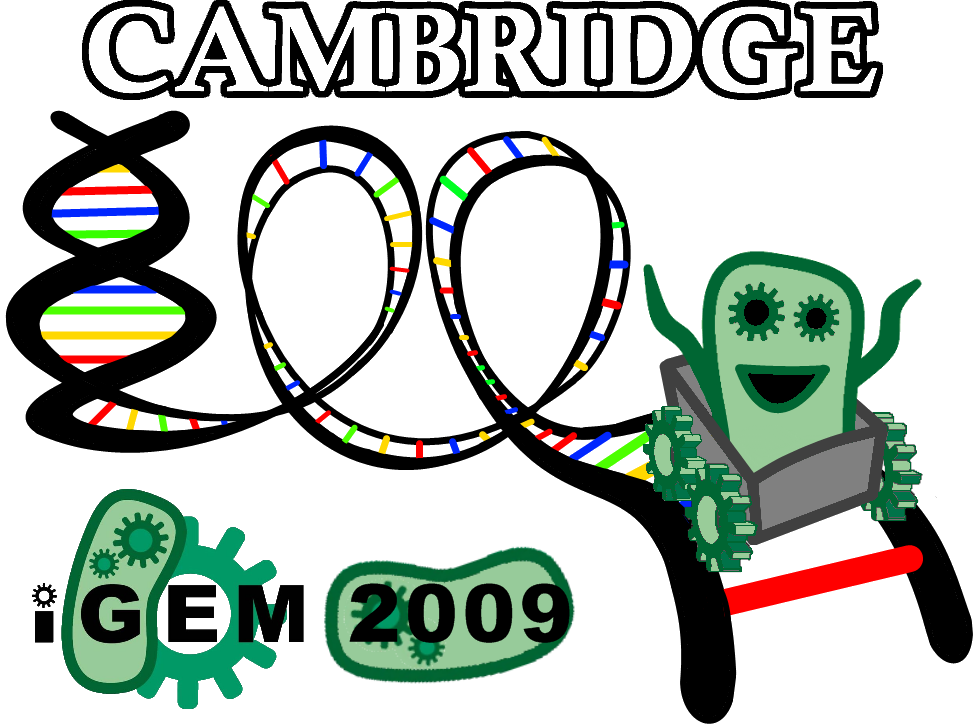Team:Cambridge
From 2009.igem.org
MikeDavies (Talk | contribs) (→The Team) |
|||
| (83 intermediate revisions not shown) | |||
| Line 1: | Line 1: | ||
{{Template:Cambridge2}}<!--Do not remove the first and last lines in this page!--> | {{Template:Cambridge2}}<!--Do not remove the first and last lines in this page!--> | ||
| - | + | =E. Chromi= | |
| - | + | [[Image:Cambridge_Frontpage2.png|400px|right]] | |
| - | + | [[Image:RAINBOW.png|400px|right]] | |
| + | '''The Cambridge [https://2009.igem.org/Main_Page 2009 iGEM] team has created two kits of parts that will facilitate the design and construction of biosensors in the the future. | ||
| - | + | Previous iGEM teams have focused on genetically engineering bacterial biosensors by enabling bacteria to respond to novel inputs, especially biologically significant compounds. There is an unmistakable need to also develop devices that can '''1) manipulate input by changing the behaviour of the response of the input-sensitive promoter''', and that can '''2) report a response using clear, user-friendly outputs'''. The most popular output is the expression of a fluorescent protein, detectable using fluorescence microscopy. But, what if we could simply see the output with our own eyes? | |
| + | |||
| + | We successfully characterised a set of transcriptional systems for calibrated output - [https://2009.igem.org/Team:Cambridge/Project/Amplification Sensitivity Tuners]. We also successfully expressed a spectrum of pigments in ''E. coli,'' designing a set of [https://2009.igem.org/Team:Cambridge/Project/Pigments Colour Generators]. | ||
| + | |||
| + | |||
| + | |||
| + | |||
| + | |||
| + | |||
| + | |||
| + | |||
| + | |||
| + | |||
| + | |||
| + | |||
| + | |||
| + | |||
| + | |||
| + | |||
| + | |||
| + | |||
| + | |||
| + | |||
| + | |||
| + | |||
| + | |||
| + | |||
| + | |||
| + | |||
| + | |||
| + | |||
| + | |||
| + | <html> | ||
| + | <style type="text/css"> | ||
| + | .imagelink_1 a { | ||
| + | width:240px; | ||
| + | height:160px; | ||
| + | display:block; | ||
| + | position:absolute; | ||
| + | left:30px; | ||
| + | top:460px; | ||
| + | text-decoration:none; | ||
| + | background-image: url("https://static.igem.org/mediawiki/2009/5/50/Frontpage1.png") | ||
| + | } | ||
| + | .imagelink_2 a { | ||
| + | width:240px; | ||
| + | height:160px; | ||
| + | display:block; | ||
| + | position:absolute; | ||
| + | left:270px; | ||
| + | top:460px; | ||
| + | text-decoration:none; | ||
| + | background-image: url("https://static.igem.org/mediawiki/2009/b/bd/Frontpage2b.png") | ||
| + | } | ||
| + | .imagelink_3 a { | ||
| + | width:240px; | ||
| + | height:160px; | ||
| + | display:block; | ||
| + | position:absolute; | ||
| + | left:510px; | ||
| + | top:460px; | ||
| + | text-decoration:none; | ||
| + | background-image: url("https://static.igem.org/mediawiki/2009/3/3d/Frontpage3.png") | ||
| + | } | ||
| + | .imagelink_4 a { | ||
| + | width:240px; | ||
| + | height:160px; | ||
| + | display:block; | ||
| + | position:absolute; | ||
| + | left:30px; | ||
| + | top:620px; | ||
| + | text-decoration:none; | ||
| + | background-image: url("https://static.igem.org/mediawiki/2009/f/f7/Frontpage4.png") | ||
| + | } | ||
| + | .imagelink_5 a { | ||
| + | width:240px; | ||
| + | height:160px; | ||
| + | display:block; | ||
| + | position:absolute; | ||
| + | left:270px; | ||
| + | top:620px; | ||
| + | text-decoration:none; | ||
| + | background-image: url("https://static.igem.org/mediawiki/2009/5/53/Frontpage5.png") | ||
| + | } | ||
| + | .imagelink_6 a { | ||
| + | width:240px; | ||
| + | height:160px; | ||
| + | display:block; | ||
| + | position:absolute; | ||
| + | left:510px; | ||
| + | top:620px; | ||
| + | text-decoration:none; | ||
| + | background-image: url("https://static.igem.org/mediawiki/2009/f/f6/Frontpage6.png") | ||
| + | } | ||
| + | </style> | ||
| + | </html> | ||
| + | |||
| + | <div class="imagelink_1">[https://2009.igem.org/Team:Cambridge/Project]</div><div class="imagelink_2">[https://2009.igem.org/Team:Cambridge/Project/Amplification]</div><div class="imagelink_3">[https://2009.igem.org/Team:Cambridge/Project/Pigments]</div><div class="imagelink_4">[https://2009.igem.org/Team:Cambridge/ImageGallery/TEAM]</div><div class="imagelink_5">[https://2009.igem.org/Team:Cambridge/Team]</div><div class="imagelink_6">[https://2009.igem.org/Team:Cambridge/ImageGallery]</div> | ||
| + | |||
| + | ==== The E. Chromi Team, in Cambridge's 800th year ==== | ||
| + | [[Image:Cambridgeteamphoto.png | 360px]][[Image:IGEMTSHIRTtrans2.png | 360px]] | ||
| + | <!--Do not remove the first and last lines in this page!-->{{Template:CambridgeBottom}} | ||
Latest revision as of 00:10, 22 October 2009
Categories :
Project :
-
Overview
Sensitivity Tuner
--- Characterisation
--- Modelling
Colour Generators
--- Carotenoids (Orange/Red)
--- Melanin (Brown)
--- Violacein (Purple/Green)
The Future
Safety
Notebook :
Team Logistics :
E. Chromi
The Cambridge 2009 iGEM team has created two kits of parts that will facilitate the design and construction of biosensors in the the future.
Previous iGEM teams have focused on genetically engineering bacterial biosensors by enabling bacteria to respond to novel inputs, especially biologically significant compounds. There is an unmistakable need to also develop devices that can 1) manipulate input by changing the behaviour of the response of the input-sensitive promoter, and that can 2) report a response using clear, user-friendly outputs. The most popular output is the expression of a fluorescent protein, detectable using fluorescence microscopy. But, what if we could simply see the output with our own eyes?
We successfully characterised a set of transcriptional systems for calibrated output - Sensitivity Tuners. We also successfully expressed a spectrum of pigments in E. coli, designing a set of Colour Generators.
 "
"



